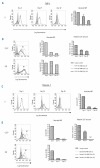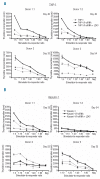Class II-associated invariant chain peptide down-modulation enhances the immunogenicity of myeloid leukemic blasts resulting in increased CD4+ T-cell responses
- PMID: 19903675
- PMCID: PMC2833080
- DOI: 10.3324/haematol.2009.010595
Class II-associated invariant chain peptide down-modulation enhances the immunogenicity of myeloid leukemic blasts resulting in increased CD4+ T-cell responses
Abstract
Background: Disease recurrence in patients with acute myeloid leukemia may be partially explained by the escape of leukemic blasts from CD4(+) T-cell recognition. The current study investigates the role of aberrant HLA class II antigen presentation on leukemic blasts by determining both the clinical and functional impact of the class II-associated invariant chain peptide (CLIP).
Design and methods: The levels of expression of CLIP and HLA-DR on blood and bone marrow samples from 207 patients with acute myeloid leukemia were correlated with clinical outcome. Irradiated CLIP(-) and CLIP(+) leukemic blasts were compared for their ability to induce CD4(+) T cells during mixed leukocyte reactions. To discriminate between these blasts, we down-modulated CLIP expression on myeloid leukemic cell lines by RNA interference of the invariant chain, a chaperone protein critically involved in HLA-DR processing, and performed flow cytometric sorting for their isolation from primary acute myeloid leukemia samples.
Results: We found that patients with leukemic blasts characterized by a high amount of HLA-DR occupied by CLIP (relative amount of CLIP) had a significantly shortened disease-free survival. The clear reductions in amount of HLA-DR occupied by CLIP on blasts of the THP-1 and Kasumi-1 myeloid leukemic cell lines after treatment with invariant chain short interfering RNA resulted in enhanced rates of allogeneic CD4(+) T-cell proliferation. Similar findings were obtained in an autologous setting, in which there were strong increases in proliferation of remission CD4(+) T cells stimulated with CLIP(-)-sorted leukemic blasts from HLA-DR(+) acute myeloid leukemia patients, in contrast to CLIP(+)-sorted leukemic blasts from the same patients.
Conclusions: These data highlight the relevance of CLIP expression on leukemic blasts and the potential of CLIP as a target for immunomodulatory strategies to enhance HLA class II antigen presentation and CD4(+) T-cell reactivity in acute myeloid leukemia.
Figures




Similar articles
-
Absence of class II-associated invariant chain peptide on leukemic blasts of patients promotes activation of autologous leukemia-reactive CD4+ T cells.Cancer Res. 2011 Apr 1;71(7):2507-17. doi: 10.1158/0008-5472.CAN-10-3689. Epub 2011 Feb 10. Cancer Res. 2011. PMID: 21310823
-
Alternative Ii-independent antigen-processing pathway in leukemic blasts involves TAP-dependent peptide loading of HLA class II complexes.Cancer Immunol Immunother. 2010 Dec;59(12):1825-38. doi: 10.1007/s00262-010-0908-z. Epub 2010 Sep 5. Cancer Immunol Immunother. 2010. PMID: 20820776 Free PMC article.
-
Class II-associated invariant chain peptide expression on myeloid leukemic blasts predicts poor clinical outcome.Cancer Res. 2004 Aug 15;64(16):5546-50. doi: 10.1158/0008-5472.CAN-04-1350. Cancer Res. 2004. PMID: 15313888
-
Targeted immunotherapy in acute myeloblastic leukemia: from animals to humans.Cancer Immunol Immunother. 2005 Oct;54(10):933-43. doi: 10.1007/s00262-005-0678-1. Epub 2005 May 12. Cancer Immunol Immunother. 2005. PMID: 15889256 Free PMC article. Review.
-
MS-Based HLA-II Peptidomics Combined With Multiomics Will Aid the Development of Future Immunotherapies.Mol Cell Proteomics. 2021;20:100116. doi: 10.1016/j.mcpro.2021.100116. Epub 2021 Jun 17. Mol Cell Proteomics. 2021. PMID: 34146720 Free PMC article. Review.
Cited by
-
Targeting Toll-like receptor 7/8 enhances uptake of apoptotic leukemic cells by monocyte-derived dendritic cells but interferes with subsequent cytokine-induced maturation.Cancer Immunol Immunother. 2011 Jan;60(1):37-47. doi: 10.1007/s00262-010-0917-y. Epub 2010 Sep 22. Cancer Immunol Immunother. 2011. PMID: 20859626 Free PMC article.
-
HLA class II antigen-processing pathway in tumors: Molecular defects and clinical relevance.Oncoimmunology. 2017 Feb 6;6(2):e1171447. doi: 10.1080/2162402X.2016.1171447. eCollection 2017. Oncoimmunology. 2017. PMID: 28344859 Free PMC article. Review.
-
Modification of an exposed loop in the C1 domain reduces immune responses to factor VIII in hemophilia A mice.Blood. 2012 May 31;119(22):5294-300. doi: 10.1182/blood-2011-11-391680. Epub 2012 Apr 12. Blood. 2012. PMID: 22498747 Free PMC article.
-
Promiscuous binding of invariant chain-derived CLIP peptide to distinct HLA-I molecules revealed in leukemic cells.PLoS One. 2012;7(4):e34649. doi: 10.1371/journal.pone.0034649. Epub 2012 Apr 26. PLoS One. 2012. PMID: 22563374 Free PMC article.
-
Statins markedly potentiate aminopeptidase inhibitor activity against (drug-resistant) human acute myeloid leukemia cells.Cancer Drug Resist. 2023 Jul 4;6(3):430-446. doi: 10.20517/cdr.2023.20. eCollection 2023. Cancer Drug Resist. 2023. PMID: 37842233 Free PMC article.
References
-
- Lowenberg B, Downing JR, Burnett A. Acute myeloid leukemia. N Engl J Med. 1999;341(14):1051–62. - PubMed
-
- Schreiber RD. Cancer vaccines 2004 opening address: the molecular and cellular basis of cancer immunosurveillance and immunoediting. Cancer Immun. 2005;5 (Suppl 1):1. - PubMed
-
- Greiner J, Schmitt M, Li L, Giannopoulos K, Bosch K, Schmitt A, et al. Expression of tumor-associated antigens in acute myeloid leukemia: implications for specific immunotherapeutic approaches. Blood. 2006;108 (13):4109–17. - PubMed
Publication types
MeSH terms
Substances
Grants and funding
LinkOut - more resources
Full Text Sources
Other Literature Sources
Medical
Research Materials

